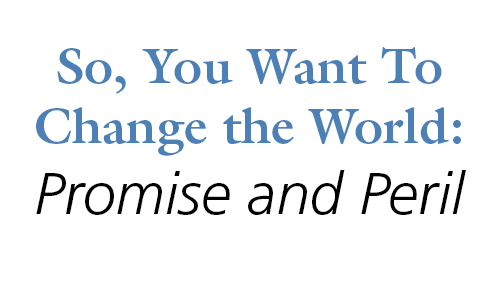By Dr. Vincent Jungkunz and Dr. Ayesha Hardison
College of Arts & Sciences faculty are tackling the challenges of the 21st century by building interdisciplinary and team-taught courses around a new set of curricular themes.
In the Love and Hate theme, we explore at least two major understandings of the spaces between love and hate as they help us understand the ongoing importance of race, gender, and sexuality. First, there are the ways that boundaries between social groups create affective distance. Race, gender, and sexuality are major identity formations that are constituted and perpetuated, produced and reproduced, between love and hate. These social groupings influence how love is distributed, how hate is defined, who can love, who is deemed lovable/un-lovable, who is subjected to hate, and, consequently, how opportunities and resources are allocated. In other words, we explore the relationships between love, hate, and power—how love, hate, and power construct and perpetuate race, gender, and sex in ways that bring some people together, tear others apart, and therefore maintain privileges, disadvantages, and ensuing inequalities.
A second, but related, understanding of the distance between love and hate that we interrogate involves the ways that love and hate co-construct each other, and the nexus between love and hate. One of the assumptions behind the claim that there is a thin line between love and hate is that these two sentiments are more closely related than we may usually admit—that a given couple’s fierce arguments (the opposite of love-oriented behavior) are actually signs of that couple’s deep love (their love is so intense, the stakes so high, that when conflict arises, they argue with an intensity that resembles hate). Another, and sometimes related assumption about the thinness of the line between love and hate, is that those who act hatefully toward others actually need and may really love such others, and vice versa. While such assumptions may act as mechanisms for rationalizing inappropriate behaviors or unjust power structures, they do encourage critical thinking about the shifting boundaries of love and hate, the thickness and thinness of such boundaries, the politics of such boundaries, and the socially constructed character of these boundaries.
In the 21st century, the organization of political, economic, and social boundaries remains persistently racialized, gendered, and sexualized. Unlike aspects of identity such as religious orientation, national identity or political affiliation, race, gender, and even sexuality are ascribed as immutable aspects of the self. Despite much complicating scientific and historical evidence to the contrary, race and gender are still “naturalized.” This accounts in no small part for their enduring significance. Approaches to ecological sustainability, the politics of war and peace, the organization of wealth and poverty, immigration politics, the creation and practice of law, rights to love and marriage, and the relative security of access to basic resources such as food, water, education, and housing—close analysis of all these practices reveals the centrality of race, gender, and sexuality to the organization of social conflict and political power. Given this, we prioritize these categories while exploring their relationships to other aspects of identity. We ask, when thinking about powerful boundaries related to race, gender, and sexuality: “is there really a thin line between love and hate?” From such a simple question, a whole series of questions emerge:
- How have our understandings of race, gender, and sexuality changed over time?
- How are the thinness and/or thickness of the lines between love and hate racialized, gendered, and sexualized differently for each category?
- What does this line look like related to Whiteness?
- How has it been constructed according to masculinity?
- What about heteronormativity?
- How are such lines constructed as these categories intersect with one another?
- How do they vary across and within cultures?
- What happens when such lines are transgressed, both the lines between love and hate and the boundaries between whites and blacks, or men and women, or gay and straight?
- How have such boundaries been “naturalized” in our social discourses, and how do such naturalization processes perpetuate divisions?
- What role do race, gender, and sexuality continue to play in the era of universal “human” rights?
- What aspects of the experience of gender are shared cross-culturally?
- What role do race and gender play in the organization of domestic and global labor?
- How do race, gender, and sexuality shape the distributions of opportunities across societies?
- What role do shared experience play in mobilizing for social transformation?
- How has colonialism shaped the meanings and roles of race, gender, and sexuality?
- How do notions of racial and sexual purity, and of natural gender roles, continue to inform our personal and political choices?
- Finally, in the epic battle between love and hate, what are our chances that love will emerge victorious, and that the divisions between us will be overcome by the ties that bind?
Ohio University faculty are invited to attend the first annual “Themes Fest” on Nov. 5 from 2-4 p.m., in the Nelson Commons Reception Area.
Themes Fest provides an update on the curricular themes initiative launched in the College of Arts & Sciences last spring. [See A&S Faculty Bring Curricular Themes to Life.]
Dr. Vincent Jungkunz is Assistant Professor of Political Science in Ohio University’s College of Arts & Sciences. He also participates in the Center for Law, Justice and Culture.
Dr. Ayesha Hardison is Associate Professor of English in the College of Arts & Sciences.



















Comments